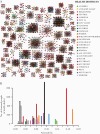Interplay Between Geography and HIV Transmission Clusters in Los Angeles County
- PMID: 34159215
- PMCID: PMC8212943
- DOI: 10.1093/ofid/ofab211
Interplay Between Geography and HIV Transmission Clusters in Los Angeles County
Abstract
Background: Clusters of HIV diagnoses in time and space and clusters of genetically linked cases can both serve as alerts for directing prevention and treatment activities. We assessed the interplay between geography and transmission across the Los Angeles County (LAC) HIV genetic transmission network.
Methods: Deidentified surveillance data reported for 8186 people with HIV residing in LAC from 2010 through 2016 were used to construct a transmission network using HIV-TRACE. We explored geographic assortativity, the tendency for people to link within the same geographic region; concordant time-space pairs, the proportion of genetically linked pairs from the same geographic region and diagnosis year; and Jaccard coefficient, the overlap between geographical and genetic clusters.
Results: Geography was assortative in the genetic transmission network but less so than either race/ethnicity or transmission risk. Only 18% of individuals were diagnosed in the same year and location as a genetically linked partner. Jaccard analysis revealed that cis-men and younger age at diagnosis had more overlap between genetic clusters and geography; the inverse association was observed for trans-women and Blacks/African Americans.
Conclusions: Within an urban setting with endemic HIV, genetic clustering may serve as a better indicator than time-space clustering to understand HIV transmission patterns and guide public health action.
Keywords: HIV infections/transmission; cluster analysis; molecular epidemiology.
© The Author(s) 2021. Published by Oxford University Press on behalf of Infectious Diseases Society of America.
Figures


References
-
- Mentasti M, Afshar B, Collins S, et al. . Rapid investigation of cases and clusters of Legionnaires’ disease in England and Wales using direct molecular typing. J Med Microbiol 2016; 65:484–93. - PubMed
-
- Chudy M, Budek I, Keller-Stanislawski B, et al. . A new cluster of hepatitis A infection in hemophiliacs traced to a contaminated plasma pool. J Med Virol 1999; 57:91–9. - PubMed

